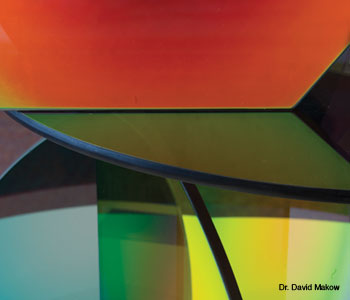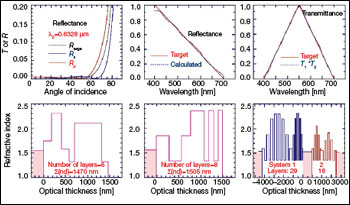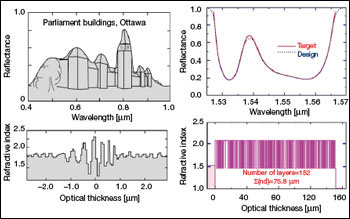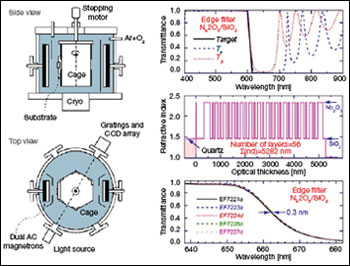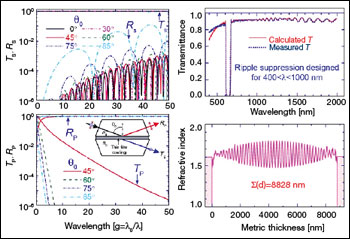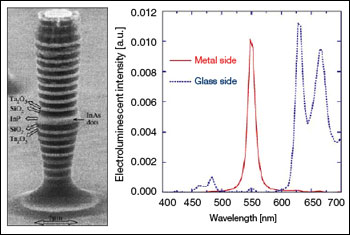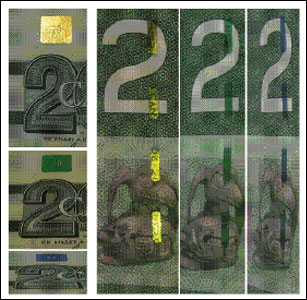The National Research Council (NRC) of Canada began its work on optical thin film interference coatings in 1956. The first refereed paper published from the Thin Films Group appeared in the Journal of the Optical Society of America in 1959. It dealt with narrow-band interference filters based on mica spacers with half-widths as narrow as 1 Å.1 The group grew from one person to 18 people at its peak. Nowadays, about 10 scientists and technicians work in the optical thin films field within the Group of Epitaxial and Multilayered Materials at the Institute for Microstructural Sciences at the NRC. Although the group is always embarking on new projects, it also continues to build upon its past endeavors; we believe it is important not to lose skills that took many decades to acquire. The group’s research areas have been in thin film coating design, the development of advanced deposition processes and thin film applications.
Thin film designThe group’s early work focused on the design of optical interference filters, and this activity is ongoing.2 The group was an early pioneer in the design of thin film synthesis methods that required no starting designs, or only rudimentary ones. The first paper on this topic was published in 1965 and described the comprehensive search and gradual evolution methods. The comprehensive search method was designed to find global minimum solutions to problems. However, it was very computation-intensive at that time, and could only be applied to problems that could be solved with a relatively small number of layers (Appl. Opt. 4, 937-46). A typical example is an antireflection coating for the He-Ne laser wavelength with an average reflectance smaller than 1 percent for all angles up to 60º3. The gradual evolution method could be applied to problems that required many more layers for a solution. Up to six layers at a time were added to the system until the number of construction parameters and the overall system thickness were large enough to find a satisfactory solution to the problem. However, that solution could no longer be guaranteed to be a global minimum. A filter in which the reflectance varied in a linear manner from 1.0 to 0.0 in the 0.4 to 0.7 μm spectral region is a typical early result. 3 The minus filter method developed at the NRC and published in 1973 is based on the superposition of filters that transmit all the incident light except in a narrow spectral region. The center wavelength, half-width and attenuation of such regions can be selected at will. The desired transmittance curve is decomposed into a series of notches corresponding to minus filters, which can then be superimposed on each other on one or two sides of a substrate and refined for further improvements. A typical result obtained by this method was a filter in which the transmittance varied linearly from 0 at 0.4 μm, to 1.0 at 0.55 μm, to 0.0 at 0.7 μm.4
Pegis, Delano, Sossi and Kard described inverse Fourier transform methods for thin film design that could find the refractive index profile of an inhomogeneous layer with the required variation of transmittance or reflectance with wavelength, providing that this variation could be expressed in terms of an analytical function that could be integrated. This development was simultaneously promising and very limiting, because it is difficult to find analytical functions that describe the sometimes very complicated spectral curves required for real problems. At the NRC in 1978, researchers developed a numerical inverse Fourier transform method that accepted tabular input of the required performance.5 This was the first time it was possible to design a filter with almost any spectral transmittance or reflectance curve for a normal incidence of light, provided that the spectral region over which the curve is defined is not excessive. The inhomogeneous layer solutions could readily be transformed into multilayer systems consisting of two or more materials. A typical example is a filter with a spectral transmittance that corresponds to the silhouette of the Parliament Buildings in Ottawa. |
The group has also developed its own versions of Bill Southwell’s “flip-flop” method and Alexander Tikhonravov’s “needle” method with powerful features that did not exist at that time in the original programs. 6,7 We’ve also developed procedures that made possible the design of filters with specifications in two or more widely separated wavelength regions.8,9 In the 1990s, the group developed several proprietary thin film design programs, including TFDesign (for DOS-based computers) and the very versatile TFArchitect (for the Windows environment). The Thin Films Group is continuing its work on thin film design tools. The software implementation of the numerical inverse Fourier transform synthesis method has evolved into one of the group’s most powerful thin film design programs. It has changed beyond recognition from the version that was first described in 1978. It incorporates many new features, including a procedure that corrects for the approximate nature of the Q-functions used in the Fourier transform design process;11 refractive index and thickness refinement of dispersive inhomogeneous and homogeneous layer solutions;10 a needle procedure based on analytical derivatives with variable refractive index needles;12 phase optimization in the Fourier transform and refinement processes; frequency filtering for AR coating design13,14 and design cleaning; special procedures for the optimization of the performance of wavelength-division-multiplex (WDM) bandpass filters. The Fourier transform thin film synthesis program has been used to investigate the important question of the overall required optical thickness for the solution of various design problems15,16 and of the robustness of solutions.17 All these numerical tools have been used to design special coatings, from WDM filters to solar blind coatings,18 gain equalization filters,17 polarizing long-wavelength cutoff filters, various non-polarizing beam splitters, bandpass and cutoff filters based on frustrated total internal reflection,19 long wavelength cutoff filters,20 tunable bandpass filters, and broadband wide-angle AR coatings.21,22 Prototypes of many of these devices have been produced on the group’s deposition systems.23,24 In collaboration with other colleagues at the Institute for Microstructural Sciences, the Thin Film Group has worked to produce materials with extremely low refractive indices.25 Precise manufacture of optical multilayer coatingsAfter the initial successes in optical thin film design, the group turned its attention to improving manufacturing processes. This is because the design techniques quickly outpaced the capabilities of the available coating equipment. At that time, the equipment frequently produced coatings that were quite porous and consequently changed their properties when exposed to the atmosphere. Further, the systems normally controlled the thicknesses of the layers using rather primitive quartz crystals or the quarter-wave monitoring method. However, the thin film designs frequently consisted of many layers of two or more coating materials with non-quarter-wave thicknesses. Thus, we needed to overcome several problems in order to take full advantage of the promising design results. First, it was necessary to find ways to monitor the thicknesses of non-quarter-wave layers in real time. The NRC developed a system with rotating sources in the early 1970s in which quarter-wave layers were monitored on a witness sample that was placed next to the substrate.26 An adjustable, rotating shutter in front of the substrate intercepted predetermined fractions of the incident vapor.
This system worked well, but could not be adapted to the deposition of hard coatings that required higher energy deposition processes. Therefore, we developed the most sensitive wavelength monitoring method for this application.26 Meanwhile, other groups around the world were working on similar problems. Emile Pelletier and his colleagues in Marseille were at the forefront of this work and perfected the wide-band monitoring technique, which was eventually applied in NRC equipment. Second, it was also crucial to find deposition processes that yielded dense coatings. There was no point in spending a lot of time and effort producing accurate coatings if their performance would deteriorate upon exposure to the atmosphere. Researchers around the world were investigating ion-assisted evaporation, ion plating and various RF- and AC-magnetron sputtering processes. After watching these developments, the group purchased an ion-plating system and designed an RF-magnetron sputtering system to its own specifications. Both systems yielded dense coatings of excellent quality, but the steady deposition rate and the repeatability of magnetron sputtering lent itself better to automation, a goal that the Group set itself as early as in the mid-1970s.27 It wasn’t until the 1990s that the group achieved complete automation of the deposition process, which included in situ determination of the layer thicknesses with re-optimization of the remaining layers to compensate for the small deposition errors.28,29 This success led to a collaborative effort with Nikon Corporation, Shincron Company and Brooks Automation (Canada) to develop a faster, AC-magnetron-based deposition system.30 Eventually, this led to the formation of Iridian Spectral Technologies, a company that specializes in the manufacture of high-precision filters. The company was initiated by Brian Sullivan and a handful of other members of the Thin Film Group. Iridian survived the telecom crash and continues to do well today. Over the past decade, the group has invested much work in the AC-magnetron sputtering system, which is now its main tool when precise, complex multilayers need to be deposited. Examples of advanced devices produced on this equipment are the Li Li polarizing beam splitter, various non-polarizing beam splitters and gain flattening filters. 31 |
This equipment is now able to deposit layers with intermediate refractive indices within homogeneous multilayer systems. Such layers are of particular importance in systems designed for use at oblique angles of incidence of light. The reproducibility and degree of control of thickness and refractive index achieved with this apparatus is now sufficient for the deposition of rugate filters.32 The ion beam sputtering system has proved to be an excellent research tool. The advantage of using in situ ion beam etching to remove thickness overshoots during the manufacture of multilayers was convincingly demonstrated in 2003.33 This system has been used with great success to produce a variety of coatings for colleagues in the Institute. Some examples of the special coatings produced in this way are facet coatings for lasers,34 mirrors for VCSELs and micro-cavity devices,35 coatings to increase the contrast and efficiency of OLEDs, and microcavity OLEDs with double-sided light emission of different colors36 and coatings for the Gemini North telescope (Altair). Anti-counterfeiting coatingsIn 1968, the Bank of Canada was looking for ideas about how to enhance the security of the nation’s currency. The group offered a proposal that would take advantage of the iridescent behavior of thin films.37,38 Normally this is an undesirable property that designers strive to minimize. However, when optical coatings are incorporated into a bank note, they change color with the angle of viewing in a way that cannot be reproduced by photography or xerography. Identicard Ltd., a company producing identification documents and drivers’ licenses, also expressed an interest in the invention. This proposal was destined to become the group’s largest project.39,40 Unfortunately, at the time, no equipment manufacturers were willing or able to supply coating machines that would produce the required large areas of accurate multilayer coatings at a low enough per-unit-area cost. A period of intense engineering efforts followed as the group successfully designed and developed two different processes.
We developed the system for the Bank of Canada in conjunction with the Canadian Vacuum Corporation Ltd., Gastops Ltd., Lembo Corporation of Canada Ltd. and Vadeco International. The system was a semi-continuous roll-coater based on electron beam evaporation onto a Mylar web.41 The group developed a batch-type RF- magnetron sputtering system for Identicard Ltd., in conjunction with Corona Vacuum Coaters Inc. In it, a large sheet of Mylar was draped over a 1.8 m-diameter, 1.8 m-high cylindrical drum that was rotating about a horizontal axis. Currently, Canadian banknotes carry the second generation of optical thin film security devices. The group has also suggested that optical thin films be used to protect optical media. Other special products and collaborationsOver the years, the Thin Film Group has developed a number of special multilayer systems that have been of interest to industry. For example, in the late 1980s, the group introduced thin metal layers into dielectric stacks to reduce the reflectance of various generic filter types.42,43 This technology is used in the construction of high-contrast TFEL and OLED displays,44 as well as black layer coatings for the artificial vision systems of the CanadArm for use in space shuttles and the space station. The group has written many scientific articles about antireflection coatings, polarizing and non-polarizing beam splitters and cutoff filters. One outstanding recent development has been the Li Li polarizing beam splitter, which offers an unprecedented performance over a broad spectral region and a wide range of angles.45 The group has also had many other significant institutional interactions. Some of the companies or institutions we have worked with include Luxell, Environment Canada, FISO, KAO, the Institute of Optics in Quebec, JDS-Fitel, Lumonics Optical, Nortel and, last but not least, its own spin-off, Iridian Spectral Technologies.
Through the yearsDuring the past 50 years, the Thin Films Group has been involved in a number of academic and commercial projects of national and international significance. It has published about 125 refereed papers and has about 25 U.S. patents to its credit. There can be no doubt that the successes of the group were due to its excellent staff and the stimulating working conditions at the NRC. AcknowledgmentsNRC scientists who belonged to the group or collaborated closely with it during the past 50 years include K.M. Baird, P.D. Carman, G. Clarke, D. Dalacu, J.A. Dobrowolski, P.D. Grant, G.R. Hanes, F. Ho, M. Laubitz, L. Li, P. Ma, N. Osborne, D. Poitras, B.T. Sullivan and P.G. Verly. Technical staff frequently made all the difference between success and failure. They include T. Cassidy, D.G. Charbonneau, Y. Guo, L. Howe, G. Laframboise, S.H. Lewis, F. Lin, G.E. Marsh, G. Marshall, L.M. Plante, T. Quance, M. Ranger, J.D. Sankey, R.H. Simpson, X. Tong, H.T. Tran, C.J. Van der Hoeven, A. Waldorf and R.L. Wilkinson. The group also hosted a number of guest workers who helped to expand its horizons. These include T. Akiyama, J. Ciosek, C. Holm, D. Menagh, C. Montcalm, Z. Pang, J. Shao, A.V. Tikhonravov and M.K. Trubetskov. Last but not least, the group benefited from the influx of “young blood”—summer students who, with their enthusiasm, contributed to the projects and were frequently invited to be co-authors of scientific publications. All of these people contributed to the successes of the group and the present staff express their appreciation to them. J.A. Dobrowolski, Dan Dalacu, Li Li, Penghui Ma, Daniel Poitras and Pierre G. Verly are with the Institute for Microstructural Sciences, National Research Council of Canada, Ontario, Canada. |
|
References and resources 1. J.A. Dobrowolski. "Mica Interference Filters with Transmission Bands of Very Narrow Half-Widths," J. Opt. Soc. Am. 49, 794-806 (1959).2. J.A. Dobrowolski. "Numerical methods for optical thin films," Opt. Photon. News 8, 24-30, 32-33 (1997).3. J.A. Dobrowolski. "Completely Automatic Synthesis of Optical Thin Film Systems," Appl. Opt. 4, 937-46 (1965).4. J.A. Dobrowolski. "Subtractive method of optical thin-film interference filter design," Appl. Opt. 12, 1885-93 (1973).5. J.A. Dobrowolski and D. Lowe. "Optical thin film synthesis program based on the use of Fourier transforms," Appl. Opt. 17, 3039-50 (1978).6. J.A. Dobrowolski and R.A. Kemp. "Flip-flop thin-film design program with enhanced capabilities," Appl. Opt. 31, 3807-12 (1992).7. B.T. Sullivan and J.A. Dobrowolski. "Implementation of a numerical needle method for thin-film design," Appl. Opt. 35, 5484-92 (1996).8. L. Li and J.A. Dobrowolski. "Design of optical coatings for two widely separated spectral regions," Appl. Opt. 32, 2969-75 (1993).9. J.A. Dobrowolski and L. Li. "Design of optical coatings for three or more separated spectral regions," Appl. Opt. 34, 2934-40 (1995).10. P.G. Verly. "Optical coating synthesis by simultaneous refractive-index and thickness refinement of inhomogeneous films," Appl. Opt. 37, 7327-33 (1998).11. P.G. Verly and J.A. Dobrowolski. "Iterative correction process for optical thin film synthesis with the Fourier transform method," Appl. Opt. 29, 3672-84 (1990).12. P.G. Verly. "Modified needle method with simultaneous thickness and refractive-index refinement for the synthesis of inhomogeneous and multilayer optical thin films," Appl. Opt. 40, 5718-25 (2001).13. P.G. Verly. "Fourier transform technique with frequency filtering for optical thin-film design," Appl. Opt. 34, 688-94 (1995).14. P.G. Verly. "Fourier transform technique with refinement in the frequency domain for the synthesis of optical thin films," Appl. Opt. 35, 5148-54 (1996).15. P.G. Verly. "Fourier transform approach for thickness estimation of reflecting interference filters," Appl. Opt. 45, 5636-8641 (2006).16. P.G. Verly. "Fourier transform approach for thickness estimation of reflecting interference filters. 2 Generalized theory," Appl. Opt. 46, 76-83 (2007).17. P.G. Verly. "Design of a robust thin-film interference filter for erbium-doped fiber amplifier gain equalization," Appl. Opt. 41, 3092-3096 (2002).18. N. Grandjean, A. Dussaigne, M. Mosca, J.-L. Reverchon, Verly.P.G. and R.H. Simpson. "Solar blind AlGaN photodetectors with very high spectral selectivity," Eur. Phys. J. Appl. Phys. 33, 5-7 (2006).19. L. Li, P. Ma and P.G. Verly, "Non-polarizing thin film interference filters with FTIR," Optical Interference Coatings on CD-ROM ThD3 (2004).20. J.A. Dobrowolski, L. Li and J. Hilfiker. "Long-wavelength cut-off filters of a new type," Appl. Opt. 38, 4891-5003 (1999).21. J.A. Dobrowolski, D. Poitras, M. Penghui, V. Himanshu and M. Acree. "Toward perfect antireflection coatings: numerical investigation," Appl. Opt. 41, 3075-83 (2002).
22. D. Poitras, J.A. Dobrowolski and P. Ma. "Toward perfect antireflection coatings.
|

